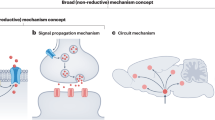Abstract
In their target article, Lynch, Parke, and O’Malley argue against the quick application of causal, interventionist explanatory frameworks to microbiomes and their purported role in many disparate states, from obesity to anxiety. I think the authors have undersold the force of their argument. A careful consideration of the scope of their claims, made easier by a parallel drawn from the history of explanation in neuroscience, yields a productive pessimism: that causal explanations likely operate at the wrong level of analysis for dynamic, distributed, Quineian entities like the microbiome. That is, we shouldn’t expect causal explanations for microbiomes at all—and this includes the authors’ own “microbiome success story” of C. difficile. Neuroscience, with its own computationally challenging, dynamic entity—the brain—may provide lessons for how to approach something like predictive control over the microbiome.
Similar content being viewed by others
Notes
Enterotypes might turn out to be a twenty-first century star-chart, with many internet services helping you “find your enterotype” and matching you to a probiotic blend that they conveniently stock.
For instance, you could train a decoding model to predict, given a pattern of neural activation, which stimulus was most likely present. Likewise, you could train an encoding model to do the opposite. Applying statistical learning techniques, including Bayesian strategies, can further the predictive power of these models, as Schoenmakers et al. (2013) demonstrate.
References
Arumugam M, Raes J et al (2011) Enterotypes of the human gut microbiome. Nature 473:174–180
Bakken JS, Borody T et al (2011) Treating Clostridium difficile infection with fecal microbiota transplantation. Clin Gastroenterol Hepatol 9:1044–1049
Barlow HB (1953) Summation and inhibition in the frog’s retina. J Physiol 119:69–88
Barlow HB (1972) Single units and sensation: a neuron doctrine for perceptual psychology. Perception 1:371–394
Buffie CG, Bucci V et al (2015) Precision microbiome reconstitution restores bile acid mediated resistance to Clostridium difficile. Nature 512:205–208
Duncan J (2001) An adaptive coding model of neural function in prefrontal cortex. Nat Rev Neurosci 2:820–829
Fiorentini C, Fabbri A et al (1998) Clostridium difficile toxin B induces apoptosis in intestinal cultured cells. Infect Immun 66(6):2660–2665
Fodor J (1983) The modularity of mind. MIT Press, Cambridge
Haynes J (2009) Decoding visual consciousness from human brain signals. Trends Cognit Sci 13(5):194–202
Haynes J (2015) A primer on pattern-based approaches to fMRI: principles, pitfalls, and perspectives. Neuron 87:257–270
Hubel DH, Wiesel TN (1962) Receptive fields, binocular interaction and functional architecture in the cat’s visual cortex. J Physiol 166:106–154
Klein C (2014) The brain at rest: what is it doing and why it matters. Philos Sci 81:974–985
Pearce JMS (2009) Marie–Jean–Peire Flourens (1794–1867) and cortical localization. Eur Neurol 61(5):311–314
Postle BR (2015) Neural bases of the short-term retention of visual information. In: Jolicoeur P, Lefebvre C, Martinez-Trujillo J (eds) Mechanisms of sensory working memory: attention and performance XXV. Academic Press, London, pp 43–58
Rafter N (2008) Somatotyping, antimodernism, and the production of criminological knowledge. Criminology 45(4):805–833
Schoenmakers S, Barth M, Heskes T, Van Gerven M (2013) Linear reconstruction of perceived images from human brain activity. Neuroimage 83:951–961
Stein RR, Bucci V et al (2013) Ecological modeling from time-series inference: insight into dynamics and stability of intestinal microbiota. PLoS Comput Biol 9(12):1–11
Voth DE, Ballard JD (2005) Clostridium difficile toxins: mec of action and role in disease. Clin Microbiol Rev 18(2):247–263
Author information
Authors and Affiliations
Corresponding author
Additional information
Publisher's Note
Springer Nature remains neutral with regard to jurisdictional claims in published maps and institutional affiliations.
This comment refers to the article available at https://doi.org/10.1007/s10539-019-9702-2.
Rights and permissions
About this article
Cite this article
Gomez-Lavin, J. Why expect causation at all? A pessimistic parallel with neuroscience. Biol Philos 34, 61 (2019). https://doi.org/10.1007/s10539-019-9713-z
Received:
Accepted:
Published:
DOI: https://doi.org/10.1007/s10539-019-9713-z




